Once Upon a Time, every plant had an air system, fed by central compressors that hissed cheerfully whether working or idling. Hey, air was free, right? Maybe then, but not today.
Energy consumption is one of the key factors determining how a machine or system is received these days. Different regions of the world have experienced differing energy costs over time. But today, users in every region want to squeeze the most bang from the fewest pneumatic bucks.
Fortunately, most major vendors of pneumatics are prepared to help you work toward this goal. Trade organizations like the USA’s National Fluid Power Assoc. (NFPA) have useful guidelines to assist in designing efficient pneumatics. International standards help ensure that compliant components, wherever built, will deliver good performance and value. And Total Cost of Ownership (TCO) guidelines, to be covered in a future Design World article, will help you choose the right type of system for your job.
Nonetheless, recent advances by several international firms have reinforced specific steps you can take to cut energy consumption in pneumatic applications. Here, from Bosch Rexroth and Festo, are steps you can take to reduce energy costs from pneumatic systems.
1: Beware of oversizing components
For decades, old-timers like this editor recall oversizing actuators. If we really needed, say, a 2-in. cylinder, then we’d specify the next size larger. At the same pressure, the larger actuator would bring more force to the task, and could better cope with heavier or misaligned loads, we surmised.
But oversizing equals waste. And the first way to increase energy efficiency is optimal dimensioning of the components used, thereby avoiding unnecessary air consumption due to oversizing. Over the life cycle of a machine, this adds up to a significant amount of money. Pneumatic components are available in a wide array of sizes, which provide the optimal conditions for precise application dimensioning. A cylinder with an application-optimized diameter can reduce air consumption by at least 15%, when compared to one with a commonly oversized diameter.
Many vendors simplify the dimensioning with online calculation and optimization programs. Through a few clicks and some basic inputs, the practical result is clearly presented including technical data and recommended components. For example, a new online air-consumption calculator from Rexroth lets you calculate and compare the resulting energy costs from the basis of compressor capacity, operating hours and the technical parameters of the actual application.
In typical installations, at least 15% of the air volume can be saved by using compact and economical designs with correctly sized cylinders and valves, and optimized nominal flows. That equates to an energy dollar savings of 15%, according to Kjell Lyngstad, Global Account manager of Bosch Rexroth.
2: Reduce volume by cutting distance between valves and actuators
You can substantially increase machine efficiency by reducing lengths of tubing runs between components. Thus dead volumes are reduced and pressure losses are avoided through shorter tube lengths.
Look closely at the advantages of decentralized air supply. Centralized valve manifolds are typically cumbersome, require long air lines, and consume a lot of energy. Vendors now offer small, decentralized valves and manifolds that concentrate pneumatic functions at the point of use. Valves can mount directly to cylinders without hose connections. This direct connection eliminates pressure losses through long lines from the control cabinet to the pneumatic drive. Valve/actuator units can reduce tubing connections by 50% and cut energy use by 35%. Decentralized systems can also yield faster response times and higher cycle frequencies.
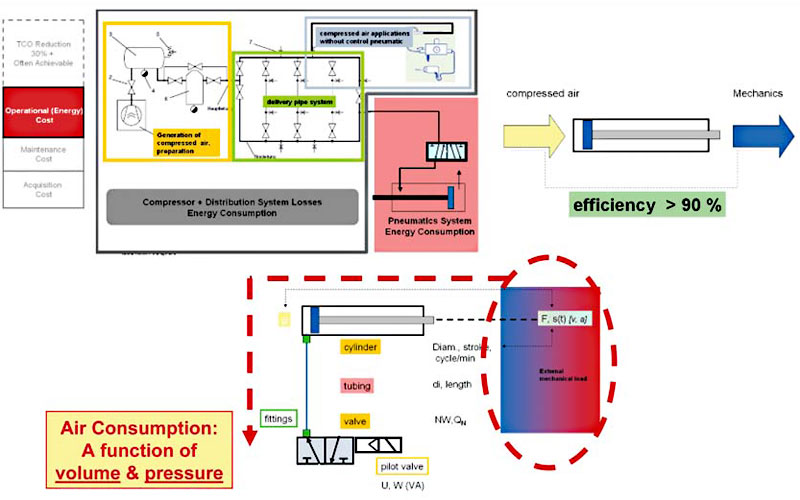
Four most common areas where energy is consumed in pneumatics systems.
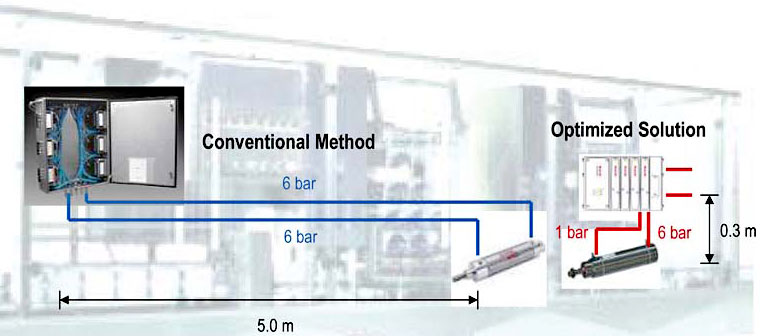
To reduce pneumatics system volume, reduce distance between valves and actuators.
If harsh operating conditions or sanitary washdowns for, say, food processing equipment are issues, look into decentralized valve units made of engineered polymers that are small, light, chemically resistant, and able to withstand harsh operating conditions. Some valves and manifolds have sanitary designs and materials suitable for food processing, eliminating need to house pneumatic valves in remote stainless-steel enclosures with long tubes running to the actuators. Rexroth makes a valve system that fulfills IP69K requirements. This system enables a significant reduction in tube lengths by allowing it to be placed directly around the actuators in the food and beverage industry, something that is not normally possible due to high-pressure cleaning requirements.
Innovative pneumatics modules with high energy density offer the cycle time advantages of decentralized automation structures and also lower air consumption up to 35%. These very compact components are so small and lightweight that they can be integrated directly on the actuators.
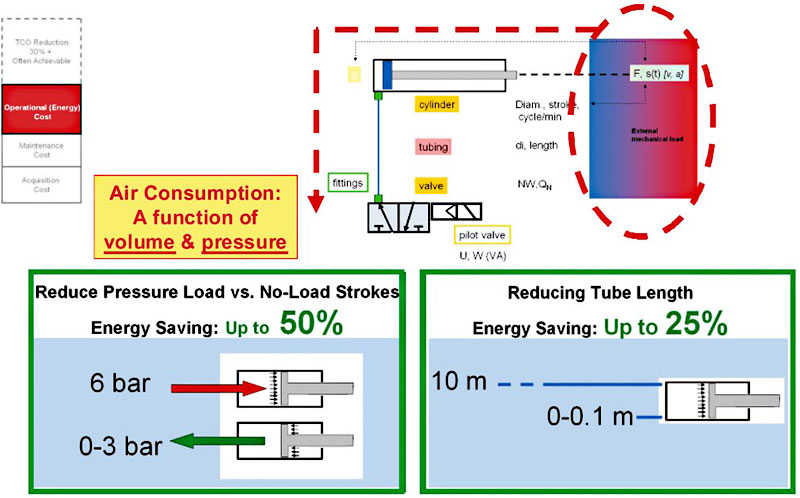
Air consumption is a function of volume & pressure. Control them both and you have managed energy consumption.
3: Avoid using excess pressure
Pneumatic systems frequently waste energy by supplying higher pressure than an actuator needs. For instance, in many applications cylinders either push or pull a load, but not both. Yet most often machines use the same pressure for both extend and retract strokes, which is extremely inefficient.
Using pressure regulators to supply the right pressure for each task can lower energy consumption by more than 25%. For instance, “smart” regulators combine digital control electronics with proportional valves. They constantly compare preset pressure limits with actual values to ensure exact metering.
Rexroth’s term for this is energy on demand, based on decentralized intelligence to adapt the pressure individually to needs and thus raising energy efficiency. The pressure profile of an actuator’s movement is divided into different phases: Start, movement, end and return stroke. Start and end phases usually require high energy, while movement and return stroke phases can be performed with a significantly lower pressure. Even if the reduced pressure usage distance appears short, it is sufficient enough to optimize the motion and to minimize hard end position stops. When many thousand repetitions of the movement are performed, the incremental savings accumulate to a noticeable efficiency increase of the entire process.
One concern to guard against: operators commonly increase supply pressure on regulators in hopes of improving performance, but this wastes significant amounts of money in air and operating costs for no actual benefit – if components are sized correctly. It is important to monitor and ensure machine pressure remains within designated limits to avoid wasting energy.
4: Minimize leakage
Every pneumatic system can save energy by avoiding leaks. Statistics from the Dept. of Energy suggest the problem is widespread: the average facility, estimates show, has 30 to 35% leakage if it hasn’t taken recent action. Valves and deteriorated seals are two common sources. Some valve designs, such as lapped-spool valves with metal seals, have inherent internal leakage that is constant as long as air is supplied to the valve. Switching to comparable valves with soft seals can significantly reduce leakage.
Another source of leaks is deterioration of seals. If standard seals are observed to degrade, consider extreme-service seals like Viton, Teflon, or polyurethane.
Modern air-preparation units are available with an integrated air-volume sensor. The sensor emits an electrical pulse each time a specific volume of compressed air has passed through the air-preparation package. The electrical pulse signals can be totaled by the controller and therefore actual air consumption (and energy costs) can be calculated for the machine over a period of time. This also lets users detect increases in machine air consumption that indicate developing leaks or nonscheduled changes to the operating pressures for the motions of the machine. The real life cost of leakage and overpressurization can be counted as well as the cost savings from correcting these problems.
According to National Resources Canada, small leakages in compressed air systems can add up to significant costs. For example, a single leak as small as 1/16 in. on a compressed air system running 24/7 at 125 PSI can cost over $1000/yr. That’s for a single leak.
Multiply those numbers by several leaks and you’re talking serious money, notes a Festo quality engineer. “When you go into a plant and hear the leaks,” he says. “That’s just money being burned up.”
Festo offers customer services including leak detection, air quality and similar air auditing services. The company also offers a new system for monitoring and diagnosing sources of air consumption in pneumatic systems. It includes pressure and flow sensors, a diagnostic controller and visualization tools so that users can to detect and fix air problems early. The company estimates optimizing application of pneumatic components coupled with proper system maintenance can lower air consumption up to 60%. At that rate, return on investment averages around six months.
Energy-efficient design of pneumatic systems
Incorrect dimensioning leads to higher costs, a reduction in quality and other problems. Learn basic solutions for correct dimensioning using real examples in this two-day course that teaches planning and designing safe optimized pneumatic systems. Working with Festo ProPneu software you will understand relationships between pressure, load and speed.
Festo Didactics
www.festo-didactic.com
Discuss this on the Engineering Exchange:

Bosch Rexroth
www.boschrexroth-us.com
Festo AG & Co. KG
www.festo.com
Filed Under: Factory automation, Pneumatic equipment + components, FLUID POWER, Energy management + harvesting

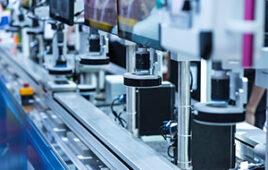


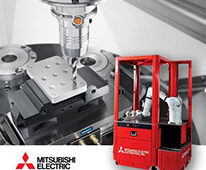
Tell Us What You Think!